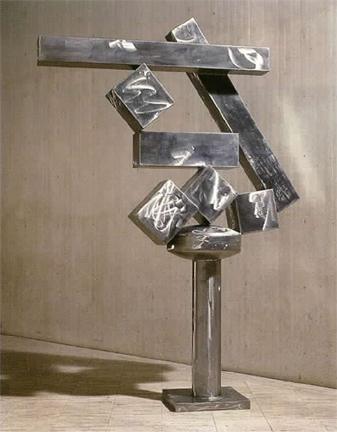David Smith
dal 13/6/2006 al 20/8/2006
Segnalato da
13/6/2006
David Smith
Centre Pompidou, Paris
Sculptures 1933 - 1964. This exhibition presents 46 of the artist's most important sculptures and 12 of his drawings, drawn from public and private collections in Europe and the United States. It retraces his career from its beginnings in the earliest welded works of the 1930s - inspired by Pablo Picasso and by Julio Gonzalez - focussing on a number of especially significant moments.

Sculptures 1933 - 1964
David Smith (1906 - 1965) was one of the most innovative and influential
sculptors of the 20th century. A pioneer in the use of welding and
of industrial materials, he revolutionised sculpture in the United States.
Marking the centenary of the artist's birth, this monographic exhibition
at the Centre Pompidou / Muse'e National d'Art Moderne, the first ever
in France, offers an unmissable opportunity to discover a great American
artist whose work is rarely seen in Europe.
This exhibition presents 46 of the artist's most important sculptures and 12 of his drawings, drawn
from public and private collections in Europe and the United States. It retraces his career from
its beginnings in the earliest welded works of the 1930s - inspired by Pablo Picasso and by Julio
Gonza'lez - focussing on a number of especially significant moments. The Surrealist-inspired works
of the 1940s are succeeded by the landscapes of 1947-51, and these by the series that Smith began
to make in the 1950s. The Agricola, Tanktotem and Voltri series testify to a continuous process
of artistic development that culminates in the late, monumental works, some in painted, some in
stainless steel. Among the latter are the Cubi, the last series the artist embarked on before his death.
Chronologically organised, the exhibition gives an insight into the whole range and complexity of
Smith's work. Its striking and radically innovative design brings out the sense of series so important
to the artist, deploying the works in an open, uncluttered space that allows the public to move around
every one of the sculptures, viewing to them from every angle.
David Smith, Sculptures 1933-1964 is organized by the Centre Pompidou in collaboration with
The Solomon R. Guggenheim Foundation and the Tate Modern, London. Presented first in New York
at the Solomon R. Guggenheim Museum from 3 February to 14 May 2006, it will be shown in Paris
from 14 June to 21 august, and then in London from 25 October 2006 to 14 January 2007.
BIOGRAPHY
David Smith was born in Decatur, Indiana, in 1906. After a year at Ohio University, Athens, in 1924-25,
he worked for a time in an automobile factory before moving to New York in 1926. In 1927, he enrolled
at the Art Student's League, studying painting under John Sloan and Jan Matulka. In the early
Thirties, Smith met the Russian e'migre' John Graham, who introduced him to avant-garde painters
Stuart Davis, Willem de Kooning, Arshile Gorky, Edgar Levy and Jean Xceron and brought them
all into contact with latest artistic developments in France. Impressed in 1929 by the welded metal
sculptures of Pablo Picasso and Julio Gonza'lez, Smith produced his first piece in welded metal
in 1933. The particular dangers of the new technique led him in 1934 to rent space for a studio in
the vast Terminal Iron Works in Brooklyn, where he worked until 1940, when he left the city for Bolton
Landing, near Lake George in the Adirondack Mountains, in upstate New York.
A first journey to Europe in 1935-36 brought a more intimate acquaintance with European artistic
developments. Returning to New York, Smith made a decisive turn towards sculpture. He was given
his first solo exhibition at the East River Gallery in January 1938, where he showed 17 sculptures
in welded steel.
The years after the war - during which he worked as a welder on tanks and locomotives - were
extremely productive. The works of the immediate post-war period are characterised by great formal
invention and imbued with a very personal symbolism. In 1947, he began an exploration of landscape
as a theme for sculpture that would come to an impressive culmination in 1951 with Australia and
Hudson River Landscape. It was then that he began to work in series, each developed over several
years and overlapping in time. The first, the Agricolas of 1951-1957, are constructed from old
agricultural machinery; in 1952 Smith produced the first of the Tanktotems, distinctively vertical
works made from elements of commercially available boilers, the last of them painted in polychrome.
Opening: 14 June 2006
Centre Pompidou
Place Georges Pompidou - Paris
Daily from 11 - 9



